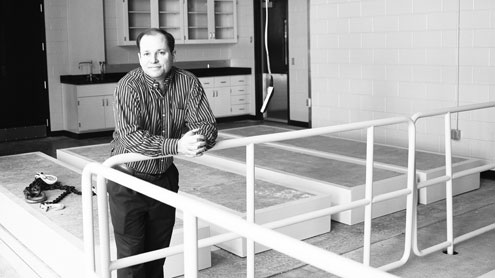An earthquake with the force to collapse a two-story building will erupt on campus in May 2012, according to a prediction made by John van de Lindt, an earthquake engineering professor. He even knows where it will take place: Room 1035 of the Southern Engineering Research Center facing Shelby Hall.
Is Lindt worried? Not in the least.
A 17-by-17-foot seismic simulator, or shake table, is expected to be ready for use in the Large Scale Structures Laboratory in the research center by May of this year. The largest of its kind in the southeast, the shake table will be able to simulate natural disasters such as earthquakes and tornadoes and the damage such disasters can inflict on buildings up to two-stories in size.
“Of course the idea of collapsing these structures isn’t just to be destructive,” Lindt said. “It’s to understand the collapse mechanism so we can design them so they don’t collapse.”
Instead of placing entire buildings on the shake table, Lindt and his students will build representative samples of the buildings they want to study. With a portion of a building on the shake table, lab computers can predict how the entire building would collapse in a natural disaster.
With four 14-foot pumps feeding 720 gallons of hydraulic fluid per minute to move structures with 140,000 pounds of force, the shake table will need all of the stability it can get.
A 32-inch concrete slab weighing more than one million pounds will hold the shake table in place. The heavy weight of the slab is intended to prevent other vibrations from interfering with data collection during testing.
The floor of the lab is intended to stabilize the shake table as well. Birdwell & Associates of Lakeland, Fla., won a 2011 Golden Trowel Award from FACE Companies for its use of precision equipment and a handheld laser to finish the floor that is flatter than most residential slabs, according to Adam Jones, director of public relations for the college of engineering.
“The floor is part of the test so with the floor it is easier to set up tests at the precision we want,” said Ken Fridley, professor of engineering, in a magazine article to be released in Capstone Engineer, the alumni magazine for the college of engineering. “We’re not starting out with a problem.”
Besides the shake table, the lab includes a soil pit to test how structures behave on the ground when undergoing an earthquake.
The soil pit is a 10-by-10-by-10-foot depression in the lab that allows Lindt and his colleagues to place the foundation of a structure in a specific sediment. The shake table will change its movement to align with how the foundation of the structure settles into the soil. The simultaneous use of the shake table and soil pit allow for University engineers to model what is called soil-structure interaction with a proximity that has never been accomplished before, Lindt said.
Although few earthquakes happen in the city of Tuscaloosa, the shake table and soil pit hybrid testing will produce research that other universities and professionals can use in the field of engineering.
“Earthquake engineering kind of lends itself to discovery well,” Lindt said. “A lot of the discoveries we make in earthquake engineering spread throughout the profession of structural engineering and even civil engineering.”







